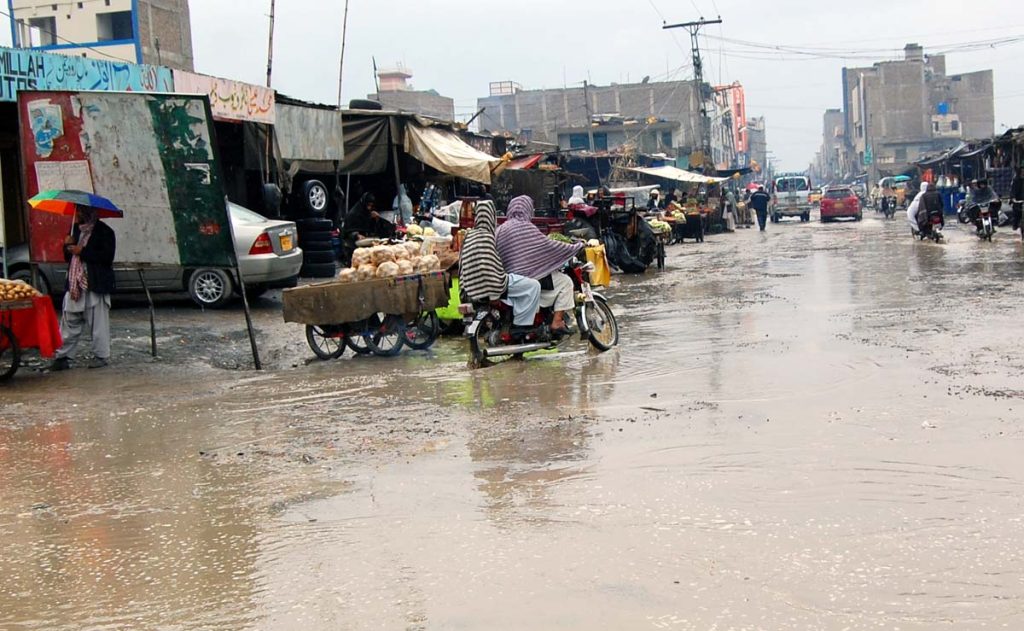
Peshawar: Climate change is a global phenomenon occurring in almost every country including Pakistan. Global warming, torrential rains, flashes floods and extreme weather are just a few indications of climate going weird for no other reason than human being’s own failings to keep its environment fit for human survival.
Overall, Pakistan’s forest cover is a paltry four percent of land area, which is one of the lowest in the world and much lower than the average of 35 percent present in environmentally healthier countries. In addition, even this meagre forest cover is under threat with one of the highest deforestation rates in the world.
For the last few years, rain in Pakistan has been relentless to the extent that it inundated cities, villages and towns. The memories of 2010 floods are still alive and fresh among both the sufferer and those who had come forward from throughout the country to help the victims survive and live through the misery.
Such misfortunes have been part of many countries’ fate; however, most of them have found a way to handle such crisis. With Pakistan, the case should not have been otherwise, had there been responsible and proactive government both at the centre and at the provincial levels. The lessons learned during the 2010 flood washed away and new memories of more horrific nature were allowed to create history in the years that followed.
“Due to changes in climate and an increase in the average temperature of the earth, the frequency of rain has decreased in some countries, whereas in others it has almost stopped. The central regions of Khyber Pakhtunkhwa (KP) had always received partial monsoon rains but for the past three years monsoon rains have become a regular phenomenon,” says Wali Khan Yousafzai, Director Flood Control Authority Irrigation Department KP.
The government, he said, has been unable to take advantage of the rains and floods with the result that water could not be stored and used for other useful activities such as electricity generation and irrigation.
In its 2013-14 floods overview report on Pakistan, the Shelter Case Studies Project, reports that during July 2010 flooding approximately 20 million people were affected and a fifth of Pakistan’s surface area was submerged and over 500,000 houses damaged.
In the September to October 2011, flooding 8.9 million people were affected and 1.5 million homes were damaged.
The floods of September 2012 affected 4.85 million people, destroyed 640,000 houses and damaged 140,000 people living in relief camps.
The floods of August 2013 affected 1.5 million people and 80,000 houses damaged.
The September 2014 flooding affected 2.5 million people and 100,000 houses damaged.
Pakistan is also the signatory of United Nations Framework on Climate Change Convention(UNFCC). During the last convention held in September 2014, the prime minister of Pakistan said that the world should come forward to combat climate change affecting nearly every nation.
Pakistan developed its own national policy on climate in 2012 with an ambition to handle the changing pattern in weather. The report has put each province responsible of managing its own climate conditions.
“It is very necessary that each province formulates its own policy on climate. Climatic conditions vary from province to province in Pakistan. A policy that suits one province or region might not be appropriate for other parts of the country. Climate change poses a serious challenge to the social, environmental and economic development,” says Wali Khan to NewsLens Pakistan.
In Peshawar, the government has been sleeping over the remedies various reports have suggested for managing climate changes.Every year the Kabul River, causes flood in most part of KP, however, no system has been devised to forewarn the people about the coming floods Yousafzai told NewsLens.
“Modern radar system should be installed at different parts of KP because the province is exposed to floods and other natural disasters,” says Yousafzai
Climate change has also affected wildlife, according to Safdar Ali Shah, the Director Wildlife Department KP. Floods, he says, do not only affect people, it also destroys wildlife and forests.
Mohammad Suliman, a Ph.D scholar on climate change in district Swat laments over the availability of insufficient data and research material on climate changes in Pakistan.
In order to make correct assessment about changing pattern in climate, historical data plays crucial role, says Suliman, adding that we all are responsible for the atmospheric changes; the ruthless cutting of trees and forests, the excessive construction on the banks of rivers and the illegal hunting of birds are the factors affecting the ecology of Pakistan.
The Billion Trees Tsunami campaign launched by the KP government under the Green Growth Initiative has been designed to bring positive climatic changes in the region. The experts, however, believe that for an effective change an awareness campaign involving ordinary people in the planning process towards climate change is actually needed.



